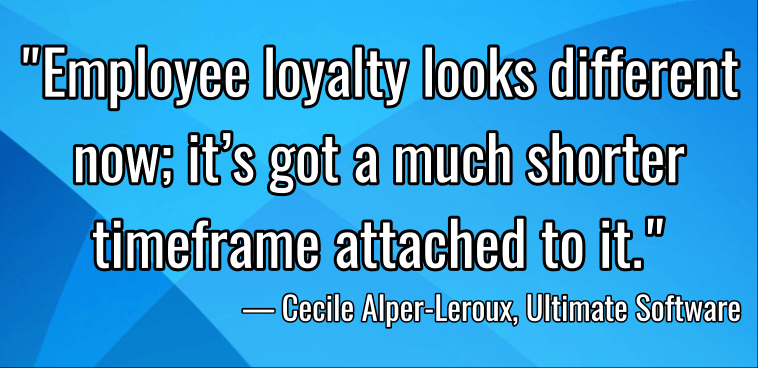Have you heard about the recent fad in the hallways of middle schools across the US? Homemade “slime,” created from laundry detergent and white glue, is a big hit at our house right now.
My daughter and her cousin spent hours one Saturday afternoon concocting bowls of this ocean breeze-scented substance. Through experimentation, they discovered a fascinating property of the mixture: there was a sweet spot to applying pressure. Too much pressure resulted in the slime “snapping” and breaking apart. Too little force caused it to stretch and sag, rendering it unusable.
Holding on tightly to something can be a good thing, like when you’re being strapped into a harness to go zip-lining or giving your kids a sturdy hug after being away from them for a while. But there is such a thing as “too much” when holding on to something, one which creates the opposite result of the holder’s intent. It’s a delicate balance, this knowing when to hold firm and when to let up.
Employee retention is a form of organizational “holding.” The concept is embedded in the language of how we view the workforce. At work, we say we want to “hold onto” top talent, and “let go” of underperforming workers.
Because the words we use inform the way we operate in organizational life, our actions reveal an either/or dichotomy in our thinking: Either we keep them, or we turn them loose. When it comes to employee tenure, a third, less-rigid option has begun to emerge.
The mindset about “retaining top talent” made sense decades ago when employees tended to stay with their employers for longer tenures. Today, there are workplace trends in play that make the notion of “keeping” employees a difficult-to-achieve objective. In the modern workplace, careers are more fluid and leadership practices have yet to catch up to this reality.
The average American worker stays in a role a mere 15 months, so it’s time to shift the perspective on employee retention.
Cecile Alper-Leroux is helping reframe the employee-retention conversation with leaders. Alper-Leroux, vice president of HCM Innovation at Ultimate Software, pays close attention to the emerging trend of workforce fluidity. Her clients tell her today’s workforce is one in which employees don’t affiliate as closely with their place of employment as they used to.
“They’re much more likely to adopt a ‘gig economy’ outlook to their careers, even if they are being paid as an employee,” she reports.
This evolving employee mindset towards employer loyalty causes leaders significant heartburn, says Alper-Leroux. Ultimate Software, a provider of cloud-based human capital management solutions, commissioned Forrester Consulting to study workforce fluidity. The resulting October 2016 survey results revealed that 50% of leaders surveyed said employees who change jobs frequently within the organization are a liability.
“Job hoppers are seen as red flags. So, on the hiring front, leaders are hesitant to hire job candidates they perceive as transient,” explains Alper-Leroux. And once they hire an employee, leaders get very protective of their talent, taking steps to ensure they stick around as long as possible.
Talent acquisition is a grind for leaders, so it’s understandable that they’d shy away from hiring someone they perceive as a flight risk. In her conversations with organizations across the globe, Alper-Leroux has found that leaders have an emotional reaction to employee turnover.
“They say to me, ‘I can’t risk losing this person!’ But the reality is, at some point, you are going to ‘lose’ them,” offers Alper-Leroux. “Employee expectations of the workplace have changed. Employee loyalty looks different now; it’s got a much shorter timeframe attached to it. It’s reasonable to expect employee loyalty, but leaders need to begin to measure it in terms of commitment, not time.”
It’s time to change the conversation about employee retention from “what can we do to keep them?” to “how can we help employees do their best work while they’re here with us?”
As Alper-Leroux points out, no matter what you do, employees most likely won’t work for you forever. At some point, they’re going to leave your team, either for an internal transfer, or for an opportunity outside your company. It’s up to you as a leader to accept this reality and make it work for your team.
Are you a leader who places strong emphasis on keeping your employees? Be sure that in your zeal to “retain” talent, you aren’t holding on too tightly. Doing so can literally squeeze the engagement right out of your most talented team members. Learn to relax the grip a bit.
It could be that when you release the mental pressure to “keep” a talented employee, a new shape of your team’s structure will take form, one that’s more fluid. But also malleable, with many options for transformation. Dare I say it? Sort of like my kid’s science creation.
Jennifer V. Miller is a freelance writer and leadership development consultant. She helps business professionals lead themselves and others towards greater career success. Join her Facebook community The People Equation and sign up for her free tip sheet: “Why is it So Hard to Shut Up? 18 Ways to THINK before you Speak.”
If you enjoyed this article, join SmartBrief’s e-mail list for our daily newsletter on being a better, smarter leader. We also have more than 200 industry-focused newsletters, all free to sign up.
